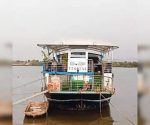Drainage expansion brings no. of pumps down from 482 to 417 | Mumbai News – Times of India

Mumbai: BMC reduced the number of dewatering pumps from 482 last year to 417 this monsoon, citing improvement in the stormwater drainage network. To prevent breakdowns of these pumps on days of heavy rain, site engineers have been instructed to keep vehicle-mounted diesel generator sets and mobile pumping systems on standby.A dewatering pumping station is designed to remove excess rainwater from low-lying areas to prevent flooding and waterlogging.These stations are important for Mumbai, where parts of the city lie below sea level. These pumps lift and discharge this excess water into nearby drains, rivers, or the sea.”Across Mumbai, 386 locations have been identified as waterlogging spots. Last year, 482 dewatering pumps were deployed to tackle monsoon flooding. Due to the expansion and improvement of the stormwater drainage network over the past year, this year 417 pumping units will be mobilised. All efforts are being made to ensure that the pumping systems and their backup mechanisms function at full capacity,” a BMC official said, adding that already, as part of pre-monsoon preparation, desilting work in rivers and major/minor nullahs across Mumbai is in full swing.On Saturday, additional municipal commissioner Abhijit Bangar inspected desilting sites in western suburbs, including Vakola river, SNDT nullah, Oshiwara river, Piramal nullah (Goregaon W), and Ramchandra nullah (Malad West).The inspection started at Vakola river that joins Mithi river downstream. There are 11 floodgates installed along Vakola river. Last year, a diesel generator pump at Golibar area failed during monsoon, causing waterlogging. Taking note of this, Bangar instructed that a vehicle-mounted diesel generator set be readily available as backup for a group of 12 pumps in the area. Mobile pumps will also be kept ready, and their response time has been asked to be minimal so they can be deployed quickly in emergencies.Mumbai: BMC reduced the number of dewatering pumps from 482 last year to 417 this monsoon, citing improvement in the stormwater drainage network. To prevent breakdowns of these pumps on days of heavy rain, site engineers have been instructed to keep vehicle-mounted diesel generator sets and mobile pumping systems on standby.A dewatering pumping station is designed to remove excess rainwater from low-lying areas to prevent flooding and waterlogging. These stations are important for Mumbai, where parts of the city lie below sea level. These pumps lift and discharge this excess water into nearby drains, rivers, or the sea.”Across Mumbai, 386 locations have been identified as waterlogging spots. Last year, 482 dewatering pumps were deployed to tackle monsoon flooding. Due to the expansion and improvement of the stormwater drainage network over the past year, this year 417 pumping units will be mobilised. All efforts are being made to ensure that the pumping systems and their backup mechanisms function at full capacity,” a BMC official said, adding that already, as part of pre-monsoon preparation, desilting work in rivers and major/minor nullahs across Mumbai is in full swing.On Saturday, additional municipal commissioner Abhijit Bangar inspected desilting sites in western suburbs, including Vakola river, SNDT nullah, Oshiwara river, Piramal nullah (Goregaon W), and Ramchandra nullah (Malad West).The inspection started at Vakola river that joins Mithi river downstream. There are 11 floodgates installed along Vakola river. Last year, a diesel generator pump at Golibar area failed during monsoon, causing waterlogging. Taking note of this, Bangar instructed that a vehicle-mounted diesel generator set be readily available as backup for a group of 12 pumps in the area. Mobile pumps will also be kept ready, and their response time has been asked to be minimal so they can be deployed quickly in emergencies.
















